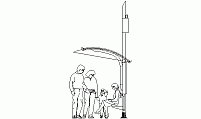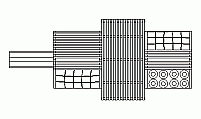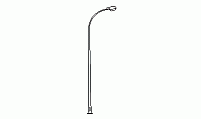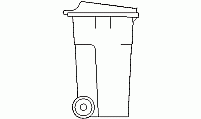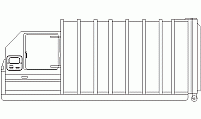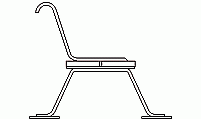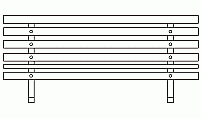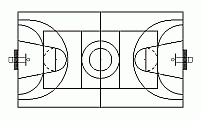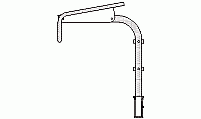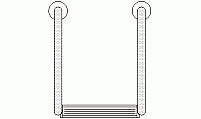CAD Blocks categories
 3D models
3D models home furniture
home furniture sanitary ware - bathrooms
sanitary ware - bathrooms professional equipment
professional equipment doors and windows
doors and windows people and animals
people and animals plants and trees
plants and trees vehicles - transports
vehicles - transports architectural details
architectural details mechanical - electrical
mechanical - electrical urban planning - civil works
urban planning - civil works safety health construction
safety health construction accessible design
accessible design drawing sheet
drawing sheet signals
signals construction machinery
construction machinery accessories and objects
accessories and objects maps and street maps
maps and street maps
Urban Bench Side Elevation CAD Design

size: 6 kb
category: street furniture
related categories:
description: A side elevation drawing of a public park bench with metal legs and a wooden seat, showcasing simple yet sturdy design for urban environments.
file extension: .dwg CAD - AutoCAD software
Comprehensive Guide to Urban Bench Designs and Standards
Urban Bench Design Overview
The side elevation of this urban bench design highlights its simple yet functional structure. The bench includes a curved backrest, providing ergonomic support for users, while the flat seat ensures comfort. The legs are crafted from durable materials, such as metal, and are flared at the base for enhanced stability. This design ensures long-term durability and minimizes risks in public spaces. The backrest and seat are designed to resist weather conditions, offering excellent performance in urban environments. This bench is ideal for parks, plazas, and other public areas where aesthetics and functionality are equally valued.
Alternative bench designs include modular systems that allow for flexible configurations, backless benches for minimalist settings, and seating integrated with tables. These designs meet diverse public space needs and often incorporate similar durable materials like treated wood, metal, and concrete. Variations in backrest shape and seat dimensions allow customization for different environments, enhancing the usability and visual appeal of outdoor spaces.
Standard Dimensions for Urban Park Benches
The typical dimensions of urban park benches are carefully designed to ensure comfort and accessibility. The seat height is commonly set at 17 inches (0.43 meters), allowing users to sit comfortably without straining their knees or backs. The seat depth typically ranges from 16 to 18 inches (0.41 to 0.46 meters), providing enough space for users of all sizes. The overall length of the bench varies, with standard sizes measuring between 60 and 72 inches (1.52 to 1.83 meters), which can comfortably accommodate multiple users. These dimensions align with ergonomic standards to ensure user satisfaction in public spaces.
Construction and Installation FAQs
- What materials are commonly used for urban benches?
- Urban benches are often made from materials like treated wood, metal, recycled plastics, or concrete. Each material offers specific advantages. Treated wood adds a natural aesthetic while resisting decay. Metals such as steel or aluminum are highly durable and can withstand harsh weather conditions. Recycled plastics are eco-friendly, require minimal maintenance, and mimic the appearance of wood. Concrete benches are vandal-resistant and ideal for areas with heavy foot traffic, providing long-lasting solutions for public spaces.
- How are benches secured to the ground?
- Benches are usually anchored using bolts and mounting plates that are secured to concrete pads or similar stable surfaces. This ensures stability and prevents the bench from tipping over due to misuse or vandalism. In some cases, embedded anchors are used during the construction phase, providing additional security. The anchoring process also prevents theft, which is especially important in public parks and high-traffic areas. Proper installation ensures that the bench remains functional and safe for long-term use.
- What safety features should be considered?
- Safety features for urban benches include rounded edges to prevent injuries, non-slip finishes on seating surfaces, and durable coatings that resist corrosion or weather damage. The materials should be free from sharp protrusions, and the bench must be securely anchored to prevent tipping. Additionally, benches should be placed on stable ground to avoid uneven surfaces, ensuring user safety. Regular maintenance is essential to identify and address any potential safety hazards, such as loose bolts or damaged parts.
- Can these benches accommodate users with disabilities?
- Yes, urban benches are often designed with accessibility in mind. They comply with standards like the ADA, which ensures appropriate seat heights, armrests for additional support, and clear ground space for wheelchair users. Accessibility features can also include easy access from paved pathways and proper bench positioning to allow comfortable use by individuals with mobility challenges. By meeting these standards, benches enhance inclusivity in public spaces.
- What maintenance is required?
- Regular maintenance is critical for the longevity and safety of urban benches. This includes cleaning surfaces to remove dirt and graffiti, inspecting for structural damage, and applying protective coatings to prevent weather-related deterioration. Wooden benches may require periodic sanding and sealing to avoid splintering, while metal benches benefit from rust-resistant treatments. Routine inspections help identify loose bolts or any damage that could compromise user safety. Proper maintenance ensures the bench remains functional and visually appealing over time.
Advantages of Urban Bench Designs
Urban benches provide numerous benefits for public and private outdoor spaces. Their robust construction ensures they withstand regular use and weather exposure, making them reliable for long-term applications. The use of durable materials such as treated wood, metal, or recycled plastics minimizes maintenance requirements while enhancing aesthetics. These benches also serve as social focal points, promoting relaxation, interaction, and community engagement. Their versatile designs fit into various environments, including parks, streetscapes, and plazas, adding both functionality and charm.
Compared to other outdoor seating options, urban benches are more durable and can be tailored to meet diverse needs. Ergonomic designs ensure user comfort, while sustainable materials contribute to eco-friendly urban planning. Customization options, including armrests, backrests, and integrated tables, make them adaptable for specific public or private requirements. These features make urban benches indispensable components of modern outdoor design, offering practical and aesthetic advantages over traditional seating solutions.
History and Evolution of Park Benches
The history of park benches dates back to the 19th century, when urban parks became integral to city planning. Early designs were made from cast iron and wood, focusing on functionality and durability. As outdoor spaces evolved, materials such as stainless steel, recycled plastics, and treated wood were introduced, offering better resistance to weather and vandalism. Today, modern benches combine durability, comfort, and aesthetic appeal to serve diverse public needs. Their evolution reflects advancements in material science and changing urban design trends.
Globally, park benches vary in design and purpose. In Europe, benches often feature artistic elements, blending functionality with visual appeal. In Asia, designs emphasize harmony with natural landscapes, using materials like bamboo or stone. In North America, sustainability has become a priority, with eco-friendly materials being widely adopted. The adaptability and innovation in bench designs ensure their relevance in urban and rural spaces worldwide, reflecting cultural and environmental influences.



